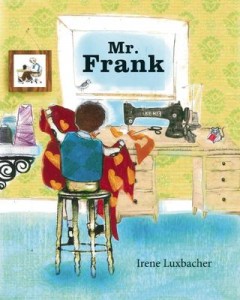January 6, 2015
Vacation Reads Part 1: Marilynne Robinson
 And now I am going to lay down a path, book by book, of how I made my way through a vacation packed with spectacular reads. It helped that I went on reading vacation a week or so before my actual vacation, abandoning myself to the task of reading all Marilynne Robinson’s novels in order. I really loved Housekeeping, and was taken by its magic and gothic sensibility. I was wary of Gilead though, as I always have been. It just didn’t seem like a book for me. But while I found it slow to start, I eventually came to appreciate it very much, and found John Ames’ worldview so admirable and beautiful, but then I was wary of that too—was I reading this like an old-age New-Age self-help guide to understanding how the world is? It is possible that I actually read all novels this way, but Gilead was so conspicuously in its, well, preachiness. Which I don’t mean as a criticism, actually. John Ames would have been an extraordinary preacher. But it is okay that I was underlining lines like they were delivered by a deity? Doesn’t this make me not far from someone who puts post-its in Chicken Soup for the Soul? So I am conflicted, but then so is Ames, which is the power of his point of view, actually. There is much subtlety at work here. That makes me nervous too. Anyway, I liked this book.
And now I am going to lay down a path, book by book, of how I made my way through a vacation packed with spectacular reads. It helped that I went on reading vacation a week or so before my actual vacation, abandoning myself to the task of reading all Marilynne Robinson’s novels in order. I really loved Housekeeping, and was taken by its magic and gothic sensibility. I was wary of Gilead though, as I always have been. It just didn’t seem like a book for me. But while I found it slow to start, I eventually came to appreciate it very much, and found John Ames’ worldview so admirable and beautiful, but then I was wary of that too—was I reading this like an old-age New-Age self-help guide to understanding how the world is? It is possible that I actually read all novels this way, but Gilead was so conspicuously in its, well, preachiness. Which I don’t mean as a criticism, actually. John Ames would have been an extraordinary preacher. But it is okay that I was underlining lines like they were delivered by a deity? Doesn’t this make me not far from someone who puts post-its in Chicken Soup for the Soul? So I am conflicted, but then so is Ames, which is the power of his point of view, actually. There is much subtlety at work here. That makes me nervous too. Anyway, I liked this book.
 I moved on to Home, which was a reread, and which turned out to be the book I liked least of the lot. While I did find it interesting to read the two books side-by-side and see how differently characters’ behaviour was interpreted by the others than what they’d intended (and the idea that came to me while I was reading KD Miller’s All Saints last summer: that we are all figments of one another’s imaginations after all), I found Home to be a bit agonizing in its repetitiveness and melodrama. Due to being on vacation and sick, I watched the stupid by entertaining movie, “They Came Together” starring Amy Poehler and Paul Rudd as I was reading Home, and maybe it was partly the head cold, but when I picked up the book again, it similarly seemed to be a spoof of sentimentality, just one darn thing after another. I don’t know if an Amy Poehler vehicle has ever been used to critique a Marilynne Robinson book before, and maybe this is my one real act of originality in this life. It is possible that reading Home and Gilead so close together wasn’t a great move after all, and perhaps I was just bored of the storyline? I do find it interesting that Gilead won the Pulitzer and Home won the Orange Prize, and I’m thinking, come on women’s fiction prize, you’ve got to up your game.
I moved on to Home, which was a reread, and which turned out to be the book I liked least of the lot. While I did find it interesting to read the two books side-by-side and see how differently characters’ behaviour was interpreted by the others than what they’d intended (and the idea that came to me while I was reading KD Miller’s All Saints last summer: that we are all figments of one another’s imaginations after all), I found Home to be a bit agonizing in its repetitiveness and melodrama. Due to being on vacation and sick, I watched the stupid by entertaining movie, “They Came Together” starring Amy Poehler and Paul Rudd as I was reading Home, and maybe it was partly the head cold, but when I picked up the book again, it similarly seemed to be a spoof of sentimentality, just one darn thing after another. I don’t know if an Amy Poehler vehicle has ever been used to critique a Marilynne Robinson book before, and maybe this is my one real act of originality in this life. It is possible that reading Home and Gilead so close together wasn’t a great move after all, and perhaps I was just bored of the storyline? I do find it interesting that Gilead won the Pulitzer and Home won the Orange Prize, and I’m thinking, come on women’s fiction prize, you’ve got to up your game.
 And then I read Lila, and I am so glad that I read all the others before because they really are a cycle, bringing us back to womanhood, daughterhood, motherhood, transiency, and a certain wildness. If The Grapes of Wrath married Gilead, this is what they’d come up with. I think what I like about Lila and Gilead over Housekeeping is that both are so engaged with the world instead of apart from it, and engagement does not require certainty. Ames and Lila really are such perfect companions, even if gaps in language and emotion keeps this from being articulated from one to the other, which is certainly a kind of faith. I suppose any marriage is.
And then I read Lila, and I am so glad that I read all the others before because they really are a cycle, bringing us back to womanhood, daughterhood, motherhood, transiency, and a certain wildness. If The Grapes of Wrath married Gilead, this is what they’d come up with. I think what I like about Lila and Gilead over Housekeeping is that both are so engaged with the world instead of apart from it, and engagement does not require certainty. Ames and Lila really are such perfect companions, even if gaps in language and emotion keeps this from being articulated from one to the other, which is certainly a kind of faith. I suppose any marriage is.
And I started underlining John Ames’ sermons again: “Life on earth is difficult and grave, and marvellous. Our experience is fragmentary. Its parts don’t add up. They don’t even belong in the same calculation. Sometimes it is hard to believe they are all parts of one thing. Nothing makes sense until we understand that experience does not accumulate like money, or memory, or like years and frailties.”
I think I will definitely have to read Lila again, this time while not so doped up on Marilynne Robinson, because it’s certainly a novel that deserves to be considered in its own right. Confession: I didn’t adore it. I don’t think I’ve quite cracked its surface yet. I also find myself at a distance from it, as I do Gilead. Both books find me unsteady as a reader, but I think that is a good thing. So I will return to it, which is the best thing about books, how you can do so over and over.
Now stay tuned for Part II of my Vacation Reads which includes (get ready for it!) the books I got for Christmas. So good.
January 4, 2015
Rose’s Run by Dawn Dumont
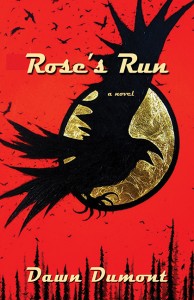 Well, if a holiday has to eventually end, Rose’s Run by Dawn Dumont is a pretty good book to go out on, a book that’s funny, breezy and heartwarming, and then manages to include a terrifying demon in the mix who feeds on the strength of women, so I was hooked in a cannot-turn-out-the-light-until-I’m-done kind of way, an I’m-going-to-have-nightmares kind of way (and I did!), and I haven’t been so gripped a scary book since I read The Troop by Craig Davidson/Nick Cutter a year ago.
Well, if a holiday has to eventually end, Rose’s Run by Dawn Dumont is a pretty good book to go out on, a book that’s funny, breezy and heartwarming, and then manages to include a terrifying demon in the mix who feeds on the strength of women, so I was hooked in a cannot-turn-out-the-light-until-I’m-done kind of way, an I’m-going-to-have-nightmares kind of way (and I did!), and I haven’t been so gripped a scary book since I read The Troop by Craig Davidson/Nick Cutter a year ago.
But let’s back up a bit. The novel begins with Rose Okanese, a First Nations woman living on a reserve in rural Saskatchewan, catching her husband bonking her cousin (and his), and then him taking off with their car so she has no way to get to work at the pig-farm. She loses her job, and has also just caught her teenage daughter doing drugs—troubles compounding. And to further compound them, Rose—through a series of misunderstandings—starts a rumour that she’s going to be running in the reserve’s annual marathon. More than a few pounds overweight and a heavy smoker, Rose is an unlikely candidate for the race, but she eventually starts training, one foot in front of the other, a seemingly insurmountable challenge, but perhaps the one thing in her world she has any control over.
If things could get any worse, it seems that her daughter and her troubled friend have managed to raise a demon from the dead, a spirt called “The Dream Woman” who feeds on the strength of the women around her and seeks vengeance for the many wrongs done to them by men. One by one, the women on the reserve become possessed by the woman’s spirit, but somehow Rose remains immune—perhaps because of the extent of her own strength as she begins to get stronger, and also somehow due to the ghost of her mother who remains a protective presence.
Soon, the marathon is the least of Rose’s problems as she is forced to battle with The Dream Woman, freeing the local women from her power (and the local men from their brutal justice), protecting her daughters in the process and sending the spirit back into the earth where she came from.
Kind of preposterous, yes, but Dawn Dumont (a comedian and broadcaster whose first novel, Nobody Cries at Bingo, was shortlisted for two Alberta book awards) balances the supernatural elements with real emotional connections between her characters, Rose’s down to earth point of view, and a wonderful ribald sense of humour. I’ve never encountered a book that managed to be hilarious and terrifying at once—and the humour never ceases, even when the suspense is at its height, but it never gets too silly either. Which makes for a really fantastic and engaging read.
While Rose’s Run would have benefitted from a stronger edit (I stumbled on a few typos and errors; the prose could have been tighter), any problems didn’t detract from my enjoyment of the novel. I read the book with an awareness of Julie Flett’s recent comments on the importance of First Nations literature:
“Our First Nation, Métis, and Inuit communities vitally need books with text and artwork that reflect our cultures and realities. Our works are also critical resources for increasing awareness and understanding in Canadian society, contributing relevancy to literacy programs, improving curricula, at all levels, across Canada, and adding significantly to the body of Canadian literature.”
There is nothing polemical about the novel at all, but not far beneath its breezy style and humour, it certainly is political, depicting the complicated reality of life on First Nations’ reserves, and in particular the status of First Nations women (whose problems at their most extreme and not so rarely either have led to the disappearance and/or murder of more than a thousand of these people in the last two decades). Now is certainly a time in which Canadian First Nations women seem to be finally starting to receive what they’re due—see the recent critical response to the television show, “Mohawk Girls“‘; the potential for a book by a First Nations woman to be part of the Canada Reads lineup for the very first time; the Native Women’s Association of Canada receiving the 2014 Vox Libera Award from Canadian Journalists for Free Expression, and more—and a book like Rose’s Run is an inspiring part of this cultural wave.
But it’s also just a really good book, and one I read avidly. A very good way to begin a new reading year.
January 3, 2015
Christmas Vacation
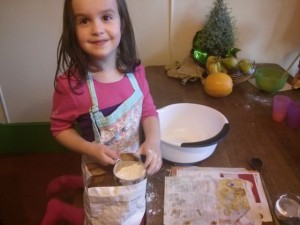 One of many reasons that members of our family are unlikely to ever take the world by storm is that our greatest talents really are for leisure—we’re experts at doing nothing, or just enough of something with requisite amounts of sofa-lying for good measure. We often visit cultural institutions such as museums and art galleries but rarely for more than an hour or two at a time, and never without a trip to the cafe AND the gift shop. Going out for lunch is our main occupation, and we always have dessert. We are really very good at enjoying ourselves, and so the last two weeks have been an absolute pleasure.
One of many reasons that members of our family are unlikely to ever take the world by storm is that our greatest talents really are for leisure—we’re experts at doing nothing, or just enough of something with requisite amounts of sofa-lying for good measure. We often visit cultural institutions such as museums and art galleries but rarely for more than an hour or two at a time, and never without a trip to the cafe AND the gift shop. Going out for lunch is our main occupation, and we always have dessert. We are really very good at enjoying ourselves, and so the last two weeks have been an absolute pleasure.
Two things: first, that I finished things up so that there was no work at all to be done for a week or so, and second, we turned off the internet. For a week, there was no checking of email or twitter, which opened up vast pockets of time in every day for all kinds of things—reading, playing, baking, carol-singing, and doing the Globe & Mail holiday crossword. On Tuesday we bought the newspaper because we were curious about what had gone on in the world, and it was odd to flip through the pages and discover news items we hadn’t heard about elsewhere.
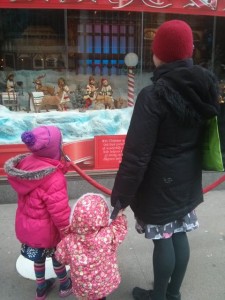 We spent the first couple of days of our holiday trying in vain to kick the cold that’s been embedded in our heads since the beginning of December. On the Sunday, we went down to the Bay on Queen Street to look at the Christmas windows, which were wonderful, and then went into the store and realized that department stores were the perfect way to reconcile our hatred of shopping malls with the joys of Christmas consumption (glittery lights, perfume smells, shopping bags with string handles, and 1 kilo tins of chocolate. Also, I now own tights without holes in the feet). Speeding home on the subway in time for Iris’s nap and for me to meet friends for an exquisite afternoon tea at Dessert Trends Bistro.
We spent the first couple of days of our holiday trying in vain to kick the cold that’s been embedded in our heads since the beginning of December. On the Sunday, we went down to the Bay on Queen Street to look at the Christmas windows, which were wonderful, and then went into the store and realized that department stores were the perfect way to reconcile our hatred of shopping malls with the joys of Christmas consumption (glittery lights, perfume smells, shopping bags with string handles, and 1 kilo tins of chocolate. Also, I now own tights without holes in the feet). Speeding home on the subway in time for Iris’s nap and for me to meet friends for an exquisite afternoon tea at Dessert Trends Bistro.
 On Monday, we went to the library (because holidaying doesn’t always have to happen on a lavish scale) and then had smoked meat lunch at Caplansky’s Deli. I also went out for dinner with my friends and drank far too much wine. On Tuesday, I don’t think we did anything, partly due to the wine. Throughout all of this, Stuart and I were watching movies and episodes of Midsomer Murders in the evening (because we are 85 years old) and Harriet watched How to Train Your Dragon Two during Iris’s nap times. On Christmas Eve, we went to the Art Gallery to see the Art Spiegelman exhibit and had a lovely brunch at the Frank Restaurant, which we save for the specialist of occasions. On the way home, we picked up our turkey, which we fastened into our stroller. That evening, we had chicken fajitas for Christmas Eve dinner for the 10th year in a row, and left a snack for Santa.
On Monday, we went to the library (because holidaying doesn’t always have to happen on a lavish scale) and then had smoked meat lunch at Caplansky’s Deli. I also went out for dinner with my friends and drank far too much wine. On Tuesday, I don’t think we did anything, partly due to the wine. Throughout all of this, Stuart and I were watching movies and episodes of Midsomer Murders in the evening (because we are 85 years old) and Harriet watched How to Train Your Dragon Two during Iris’s nap times. On Christmas Eve, we went to the Art Gallery to see the Art Spiegelman exhibit and had a lovely brunch at the Frank Restaurant, which we save for the specialist of occasions. On the way home, we picked up our turkey, which we fastened into our stroller. That evening, we had chicken fajitas for Christmas Eve dinner for the 10th year in a row, and left a snack for Santa.
 Christmas was so good. Not only did we not have to leave the house, but we got to have my mom come and visit! The children got excellent presents and had fun playing with them throughout the holidays. I received great books, nice clothes, and other lovely things, including a La Cruset butter dish I’d been hankering after and new Pyrex. We all also received new CDs (because are 85 years old and like to do 20th century things) and so the holiday has been extra-filled with music—some of which was even made after 1987, which is very rare for us. My mom arrived and played with the children (which was not very difficult—she arrived bearing her present of a trunk full of dress-up clothes) while Stuart and I set about cooking the best Christmas dinner ever. The joys of Skype brought us the company of Nana and Granddad in England, and our adorable Alberta relations.
Christmas was so good. Not only did we not have to leave the house, but we got to have my mom come and visit! The children got excellent presents and had fun playing with them throughout the holidays. I received great books, nice clothes, and other lovely things, including a La Cruset butter dish I’d been hankering after and new Pyrex. We all also received new CDs (because are 85 years old and like to do 20th century things) and so the holiday has been extra-filled with music—some of which was even made after 1987, which is very rare for us. My mom arrived and played with the children (which was not very difficult—she arrived bearing her present of a trunk full of dress-up clothes) while Stuart and I set about cooking the best Christmas dinner ever. The joys of Skype brought us the company of Nana and Granddad in England, and our adorable Alberta relations.
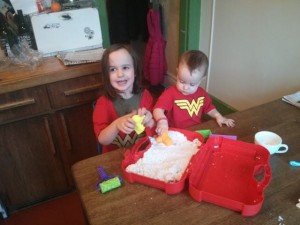 On Boxing Day, we went to the ROM, and partook in a yummy dinner of leftovers—Stuart makes the best turkey sandwiches on earth. Iris also slept until 7am for the first time in her whole life, which was mind-blowing, but also a bit terrible because when her sleep for the subsequent week was abysmal, I wanted to pitch her out the window. The next day, my dad and his partner arrived, and we all had an excellent time with them. And they played with the children while Stuart and I cooked up another very good meal—the greatest turkey pot pie of all time whose secret recipe was duck fat. The day after that, we drove out to my aunt’s in the West end, stopping en-route to buy ice-skates for Harriet and I, which had the potential to be a boondoggle. And then we had a very fun dinner with the best kinds of relations on earth—cousins.
On Boxing Day, we went to the ROM, and partook in a yummy dinner of leftovers—Stuart makes the best turkey sandwiches on earth. Iris also slept until 7am for the first time in her whole life, which was mind-blowing, but also a bit terrible because when her sleep for the subsequent week was abysmal, I wanted to pitch her out the window. The next day, my dad and his partner arrived, and we all had an excellent time with them. And they played with the children while Stuart and I cooked up another very good meal—the greatest turkey pot pie of all time whose secret recipe was duck fat. The day after that, we drove out to my aunt’s in the West end, stopping en-route to buy ice-skates for Harriet and I, which had the potential to be a boondoggle. And then we had a very fun dinner with the best kinds of relations on earth—cousins.
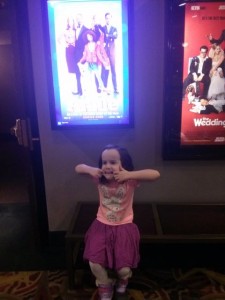 Monday was the best day—Harriet and I headed downtown to meet our friend Erin and watch the new Annie film, which we’d been looking to after avidly viewing its trailers for the past month AND after watching the old Annie every day last summer. The reviews for the new Annie were terrible and all wrong—the movie was wonderful. (That one of the critics referred to the 1982 movie as “an abomination” perhaps suggests that some people had no business reviewing either movie, both of which were masterpieces, in my humble opinion.) We all had such a good time watching it, exuberantly applauding as the credits rolled. And then we met Stuart and Iris and took the subway to Erin’s new house in Bloor West Village, which is very conveniently located near the new Book City (which was bustling and full of wonderful books.)
Monday was the best day—Harriet and I headed downtown to meet our friend Erin and watch the new Annie film, which we’d been looking to after avidly viewing its trailers for the past month AND after watching the old Annie every day last summer. The reviews for the new Annie were terrible and all wrong—the movie was wonderful. (That one of the critics referred to the 1982 movie as “an abomination” perhaps suggests that some people had no business reviewing either movie, both of which were masterpieces, in my humble opinion.) We all had such a good time watching it, exuberantly applauding as the credits rolled. And then we met Stuart and Iris and took the subway to Erin’s new house in Bloor West Village, which is very conveniently located near the new Book City (which was bustling and full of wonderful books.)
On Tuesday, I had to take a certain someone to a dermatologists to have a wart examined, which wasn’t so memorable, except that we got to stop at HMV on the way and buy the Annie soundtrack, a move supported by all members of our household. Iris can now sing “Tomorrow”, which is really something to behold. We also love Sia’s version of “You’re Never Fully Dressed Without a Smile” and the bizarre and catchy “Moonquake Lake”, with its memorable hook—”she’s a fish and he’s a boy.” That night our friends Jennie, Deep and Lilia came for dinner and the best time was had. They were kind enough not to complain about our music selection.
 Rumours of boondoggles were averted on New Years Eve when Harriet and I went skating at Christie Pits—Harriet had the best time and loved it, which was good but also troubling as it means that I have to keep going skating. We went again yesterday and both of us were vastly improved. A third jaunt is scheduled for tomorrow. New Years Eve was our traditional chocolate fondue and ringing in the UK New Year before the children went to bed. And then Stuart and I proceeded to play board games (and ping pong, until Harriet came out of her room and asked us to stop because the pinging and ponging was too noisy) until we were done, and then we went to bed and brought in the new year lit by bed-side lamps, turning away from our respective novels for a moment as the clock ticked over to 2015. Which is the best way to ring in the new that I could ever have imagined.
Rumours of boondoggles were averted on New Years Eve when Harriet and I went skating at Christie Pits—Harriet had the best time and loved it, which was good but also troubling as it means that I have to keep going skating. We went again yesterday and both of us were vastly improved. A third jaunt is scheduled for tomorrow. New Years Eve was our traditional chocolate fondue and ringing in the UK New Year before the children went to bed. And then Stuart and I proceeded to play board games (and ping pong, until Harriet came out of her room and asked us to stop because the pinging and ponging was too noisy) until we were done, and then we went to bed and brought in the new year lit by bed-side lamps, turning away from our respective novels for a moment as the clock ticked over to 2015. Which is the best way to ring in the new that I could ever have imagined.
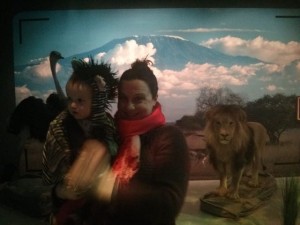 New Years Day was boring—what a wondrous indulgence is that in this day and age? Although we did have our first meal of the year at Fanny Chadwick’s for brunch, which was delicious, and Iris has been transformed into someone who is fairly respectable about restaurant behaviour from all her practice this holiday. And Harriet and I got to play Scrabble for Juniors, which is almost as excellent as spending New Year’s reading in bed. Yesterday we went to the ROM to see the Wildlife Photography exhibit. And yes, more skating. Today we’re doing nothing, which might prove to be a bad idea but feels pretty good from where I sit (on the couch, wearing jogging pants, watching snow falling outside). We’ve kept things a little special with scones with jam and Devonshire cream, because I had a jar of the latter in the fridge and we had to use it up—not the worst task to be charged with.
New Years Day was boring—what a wondrous indulgence is that in this day and age? Although we did have our first meal of the year at Fanny Chadwick’s for brunch, which was delicious, and Iris has been transformed into someone who is fairly respectable about restaurant behaviour from all her practice this holiday. And Harriet and I got to play Scrabble for Juniors, which is almost as excellent as spending New Year’s reading in bed. Yesterday we went to the ROM to see the Wildlife Photography exhibit. And yes, more skating. Today we’re doing nothing, which might prove to be a bad idea but feels pretty good from where I sit (on the couch, wearing jogging pants, watching snow falling outside). We’ve kept things a little special with scones with jam and Devonshire cream, because I had a jar of the latter in the fridge and we had to use it up—not the worst task to be charged with.
 And I’m writing it all down now mostly so that I can remember it, the holiday we were so desperate for and which so delivered. I’m writing it all down because all these ordinary things (libraries and lunches) are so easy to forget, and I don’t want to. I don’t want to forget either that we’re so blessed with friends and family and each other. If how you spend your days are indeed how you spend your life, then these past two weeks are an indication that we’re doing something right. And it’s something to hold on to as the lights of December fade—let the next few months be something more than just a countdown to spring.
And I’m writing it all down now mostly so that I can remember it, the holiday we were so desperate for and which so delivered. I’m writing it all down because all these ordinary things (libraries and lunches) are so easy to forget, and I don’t want to. I don’t want to forget either that we’re so blessed with friends and family and each other. If how you spend your days are indeed how you spend your life, then these past two weeks are an indication that we’re doing something right. And it’s something to hold on to as the lights of December fade—let the next few months be something more than just a countdown to spring.
December 31, 2014
A Happy New Year
 It was the year in which planes started disappearing from the skies. A bad year, on a global scale, and while a good year in many ways on the homefront, it’s been an exhausting autumn and I have found the wider world to be distressing and depressing. There were some days when I couldn’t bear to look out the window, let alone at newspaper headlines. And so the holiday was so very welcome when it finally arrived last week—Stuart has had two weeks off work, and we turned off our internet for the first one. I didn’t go online for a week and it was amazing. We had a very nice Christmas, and things have been very social and chocolate-covered ever since. I’ve read so many books, and they’ve all been amazing. And my online habits have still not recovered from the break so I’ve had more time to read than ever—I’d like that to continue. I like the extra time that arrives when the internet’s off.
It was the year in which planes started disappearing from the skies. A bad year, on a global scale, and while a good year in many ways on the homefront, it’s been an exhausting autumn and I have found the wider world to be distressing and depressing. There were some days when I couldn’t bear to look out the window, let alone at newspaper headlines. And so the holiday was so very welcome when it finally arrived last week—Stuart has had two weeks off work, and we turned off our internet for the first one. I didn’t go online for a week and it was amazing. We had a very nice Christmas, and things have been very social and chocolate-covered ever since. I’ve read so many books, and they’ve all been amazing. And my online habits have still not recovered from the break so I’ve had more time to read than ever—I’d like that to continue. I like the extra time that arrives when the internet’s off.
2014 was also the year in which I stopped keeping track of how many books I’ve read. I mean, I keep a qualitative count here, which seems good enough to me. Which is to say that I don’t know how many books I read this year, but oh well. I’ve also learned (from the last few weeks in particular) that I am really better off reading closer to home, following my fancies and pursuing my own curious avenues. I’m almost tempted to do a reading project like Susan Hill’s Howard’s End is On the Landing, in which she spent a year reading books from her own shelves—except that it turns out that there are many 2015 books I really am looking forward to. I just have to remember that new books are not the whole story. That perhaps it’s smart to wait on the hype. That rereading is one of the great pleasures of the reading live. That as readers, we can plot our own bookish paths. There is liberation in that. And I do have this feeling that the wayward journeys make for better blogging anyway.
As a writer, 2014 was a year of much work and good fortune—a book in the world. I faced it down 365 days ago with a great dear of terror, just as I’d eyed the year before in which we were expecting a new baby. Both baby and book turned out pretty well. This year I’m not expecting anything at all, but that’s kind of a relief. I’ve always found that those years deliver the best things anyway, and I’m intrigued by the prospect of pursuing curious avenues in my writing life as well. I have a few projects in the works—no idea if they’ll ever grow into something solid. I’m pretty convinced of the importance of fallow periods—this might be the one. And I’m excited to find out what seeds will be sown.
Stay tuned for a post about the great books I’ve read over the holidays—my final read of 2014 will be the wonderful A Man at the Helm by Nina Stibbe, which is so much fun. Up next—my first book of 2015— will be a book I bought at Book City the other day that I’d never heard of, that I plucked off the shelf because I liked the cover (and these kind of reading experiences—with room for serendipity—are what I’ve been craving). It’s a translation. Because my reading resolution for 2015 will be same as for 2014—to read more widely (which might sound incongruous with reading close to home, but it actually isn’t).
I have found these last few weeks so restful, fun and restorative—as a reader and as a human. I hope to carry that same spirit with me into the new year, and I’ll be so pleased and grateful if you come along as well. Many thanks for your friendship, support and bookish love over the past year. Wishing you all the happiest of new ones.
December 29, 2014
End the year with The M Word
 I am beginning to return to these parts after a wonderful week offline, and am turning up now with some nice news about The M Word, which I was excited to see facing out on the shelf today when I visited Bloor West Village Book City for the very first time. In the sociology section, no less.
I am beginning to return to these parts after a wonderful week offline, and am turning up now with some nice news about The M Word, which I was excited to see facing out on the shelf today when I visited Bloor West Village Book City for the very first time. In the sociology section, no less.
I was also pleased to see it included on a list of books published by the University of Toronto’s School of Continuing Studies’ instructors during 2014. It’s good company to be keeping.
Teri Vlassopoulos included The M Word on her 2014 books round-up. She writes, “the beauty of The M Word is that it’s about all different facets, from choosing to be a mother or choosing not to, having children or not having them, the difficulties and joys of being a mother or not being one.”
And the book is in fantastic company (with David Sedaris’ mother, and Jenny Offill’s book) on a list of things that made the wonderful Liz Windhorst Harmer panic less as a parent in 2014. Harmer writes, “Clare gets that it is more important for parents to hear stories than be given advice.”
I was happy to read that Rebecca Cuneo Keenan calls the book “a best book bet on motherhood” at her blog, Playground Confidential. She writes, “The M Word holds motherhood up and then turns it this way and that, exploring it from all different angles. The act of becoming a mother is one of the most identity-shaking experiences for most women. It is rivaled only by the decision to not become a mother. And Clare sets it all out for us here, giving voice to motherhood (or the lack thereof) in many of its myriad forms.”
And The M Word is in the very best company on a list of Books of the Year at the Canadian Notes & Queries blog, selected by Carmine Starnino. I was also asked to contribute to this list—which made it surprising to see my own book there—and naturally, I picked Ellen in Pieces. I’m so looking forward to rereading it for my book club in January.
December 18, 2014
Unlikely Christmas: Graham Greene’s The Little Steamroller
I don’t know that I’ve ever come across a more unlikely Christmas tale than Graham Greene’s The Little Steamroller, his fourth and final picture book.
Harriet was a big fan of The Little Horse Bus awhile back, and she liked The Little Train too, but it’s true that The Little Steamroller is perhaps the least inspired of the lot. It’s worth reading for its absolute strangeness though, for being a distilled version of a Graham Greene novel. The Little Steamroller works clearing the snow at London Airport, and ends up foiling a diamond smuggling plot by The Black Hand Gang, a nefarious pack of smugglers operating out of Africa. All this takes place over Christmas, which the Steamroller is looking forward to, because he gets very few holidays (one of which is the August Bank Holiday, and it always rained on August Bank Holiday) and because Bill Driver will wrap up his nuggets of coal in Christmas paper.
 Greene’s picture books were originally published in the 1940s and 1950s, illustrated by his mistress Dorothy Glover (the projects were intended to provide her with an income, which I think makes these books delightfully unwholesome in origin; Glover would later end it with him when she discovered there was a third woman in the mix). Our copy is one of the 1970s’ reissues, with illustrations by Edward Ardizzone, but even with this “update”, the book has a decidedly vintage feel. I don’t suppose it helps any that our copy was purchased at a yard sale, and appears to have been stored for a time in a flooded basement.
Greene’s picture books were originally published in the 1940s and 1950s, illustrated by his mistress Dorothy Glover (the projects were intended to provide her with an income, which I think makes these books delightfully unwholesome in origin; Glover would later end it with him when she discovered there was a third woman in the mix). Our copy is one of the 1970s’ reissues, with illustrations by Edward Ardizzone, but even with this “update”, the book has a decidedly vintage feel. I don’t suppose it helps any that our copy was purchased at a yard sale, and appears to have been stored for a time in a flooded basement.
Learn more about The Little Steamroller and other Graham Greene picture books at Ariel S. Winter’s blog, “We Too Were Children, Mr Barrie,” where an important question is raised but left unanswered: why ever was a steamroller being used to clear snow anyway?
December 16, 2014
Our Favourite Picture Books of 2014
 If I Wrote a Book About You by Stephany Aulenback and Denise Holmes
If I Wrote a Book About You by Stephany Aulenback and Denise Holmes
I love this book, whose prose is as whimsical and delightful as its illustrations. Its chief appeal is that it’s about love, and even comes close to describing that indescribable love we have for our children, but not before getting silly before it gets saccharine. The silliness is so good, and so is the word play, and the pleasure the book takes with words in general. Plus, Harriet is fascinated by this being a book about a hypothetical book, because she adores books in books. Of course she does.
 Sam and Dave Dig a Hole by Mac Barnett and Jon Klassen
Sam and Dave Dig a Hole by Mac Barnett and Jon Klassen
We have a huge stack of Jon Klassen’s books at our house, and his latest with Mac Barnett is beloved for its weirdness, its humour, its dog and its cat. It’s fun to read in the same deadpan voice as I Want My Hat Back, and it cleverly situates the reader as an omniscient force in the narrative, which is really empowering…until the very end when nobody knows what’s going on. Which is kind of amazing.
 Music is for Everyone by Jill Barber and Sydney Smith
Music is for Everyone by Jill Barber and Sydney Smith
Iris is chief music lover (and singer and drummer and bum shaker) in our household, and so she’s getting this book for Christmas, just so it can do some preaching to the choir. Smith (whom we know from Sheree Fitch’s books ) is a fabulous illustrator, and musician Barber knows what she’s talking about, so I think we’re going to have a lot of fun with this book, which explores the world of music and how all of us can play.
 Goodnight You by Genevieve Cote
Goodnight You by Genevieve Cote
The fourth book in Cote’s Piggy and Bunny series is her best yet. In it, the two friends go camping and find that courage and fear are relative things, and both friends can be a comfort to the other. It’s a good story with a surprise twist at the end, but I am really fond of how Cote creates a second canvas (ha) with the friends’ tent, on which they create shadow puppets to add tension and a whole other layer to the story. It’s a clever device, and the book is sweet and fun.
We are all besotted with Covello’s Toronto ABC, from which Iris has learned that there is indeed a tower on her horizon, and she points to it every time she goes outside. It’s a beautiful book, up to the moment, and a gorgeous celebration of our city and all our favourite places—the ROM, the Islands, streetcars, High Park, the AGO, and more. This kind of book is a perfect lesson for kids about how books connect with the world.
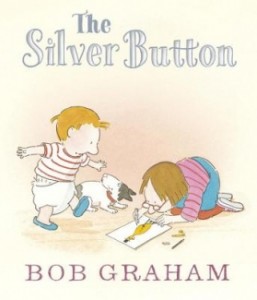 The Silver Button by Bob Graham
The Silver Button by Bob Graham
And speaking of cities, no one else writes cities in picture books quite like Bob Graham does, including the graffiti and the homeless woman pushing a shopping carts, because he wants his books to be as beautiful and complex as the world is. His latest is really wonderful, about the whole wide world and how it hinges on a single moment in which a baby takes his very first step. And I don’t just love it because I read it while I was reading Rebecca Solnit’s Wanderlust, and the connection between the two books was just uncanny.
 Julia’s House for Lost Creatures by Ben Hatke
Julia’s House for Lost Creatures by Ben Hatke
If you know Zita the Space Girl, that you’ll be thrilled to know that its creator has published his first picture book, which is as weird, wonderful and full of mystery as the Zita books. It’s about a girl called Julia whose house is on a turtle’s back, and when she settles down by the sea, she finds it all a bit too quiet. And so she opens her doors to various creatures requiring homes of their own, which brings its own complications. Being an awesome, enterprising young person, however, she figures out a way to solve her problem, and to make her house a proper home for everyone—including herself.
 Once Upon an Alphabet by Oliver Jeffers
Once Upon an Alphabet by Oliver Jeffers
This one is wrapped up and waiting under the Christmas tree, but I can’t wait to read it with Harriet. Jeffers explores the alphabet, letter by letter, imbuing each letter with a personality and life of its own. For those of us who can’t get enough of abecedarian things, the book will be sure to delight, and young readers will find it a quirky twist on their usual ABCs.
 Spic and Span by Monica Kulling
Spic and Span by Monica Kulling
Kulling’s biography of Lillian Gilbreth (who was mother of the family from Cheaper by the Dozen, not to mention a psychologist, efficiency engineer, an inventor, author and eventually a single mother to 11 children) is fascinating and Gilbreth is a great example to boys and girls that there is no limits to what a smart girl can become. Plus, she invented the shelves in your fridge door, and check out that checkerboard floor. Whoever said the domestic was dull?
I love Luxbacher’s gorgeous collage illustrations, and the sense of cultural history revealed by the story of the clothes a tailor has sewn over time—army uniforms, psychedelic mini-skirts, ripped jeans in the ’80s. But now Mr. Frank is about to sew the creation of his life—a caped ensemble that will impress those readers who are particularly enamoured with all things super-heroic. This is a super-hero story of a different sort, and a great celebration of grandparents.
Julia, Child by Kyo Maclear and Julie Morstad
Out of one kitchen and into another with this acclaimed book by a children’s literature dream team. Loosely based on the life of Julia Child and her friendship with Simca Beck (though a note advises readers to take the whole thing with a grain of salt), the story is one about the pleasures of cooking, and butter, and friendship. And to the importance of never forgetting what it is to be a child—the recipe for a happy life, perhaps?
 Peach Girl by Raymond Nakamura and Rebecca Bender
Peach Girl by Raymond Nakamura and Rebecca Bender
In Peach Girl, Nakamura turns the Japanese Momotaro folktale into a feminist celebration of feisty girldom. Momoko hatches from a peach, and then sets up to defeat an ogre in her quest to make the world a better place. She’s gutsy, unflappable, and inspires her companions. Spoilers: the ogre is just misunderstood, and they all partake in tea. Rebecca Bender’s illustrations of the Japanese countryside are stunning.
 The Secret Life of Squirrels by Nancy Rose
The Secret Life of Squirrels by Nancy Rose
Iris is still pretty choosy about books, but we have a feeling she’ll be into this one, another Christmas present. Rose’s photos of squirrels doing human things are pretty hilarious, and she’s created a fun narrative from them all. But it’s most impressive when you look in the back of the book and learn how Rose set up these photos in her own backyard (mostly by hiding nuts in her set-pieces). Iris won’t really get it though, and she’ll just like it the same way she likes the squirrels in our backyard, which she points to while shouting, “Meow!”
 The Most Magnificent Thing by Ashley Spires
The Most Magnificent Thing by Ashley Spires
This one is pretty much my ideal picture book: great images, empowered heroine who makes things, who wields a hammer, who dares to express her rage, and it all turns out okay. The takeaway too is invaluable: sometimes you have to fail in order to get anywhere. It is okay to mess up. Hard work is hard work. Perfectionism is anathema to creation. I don’t know if there is anything else I really care if my children ever learn. I love this book: the most magnificent thing indeed.
 Fisherman Through and Through by Colleen Sydor and Brooke Kerrigan
Fisherman Through and Through by Colleen Sydor and Brooke Kerrigan
It’s not often I read a picture book with a line of prose that bowls me over, but I was really struck by “…until the sun got snoozey and settled down, down on an orange cloud, toward the lip of the sea.” I love that Fisherman Through and Through is so literary—the fishermen are called Ahab, Peter and Santiago. Though the kids won’t notice that, but they’ll be compelled by this story of wishing and dreaming, and extraordinary miracles thrown up by the sea. Um, plus there is kind of a string of bunting on the cover.
December 15, 2014
All those dreams I saved for rainy days
 One day I want to write about how I met Stuart and life properly began, and how all the energy that I’d previously directed toward trying to make people fall in love with me (and despairing when I always failed) became channelled into useful things. I stopped thinking that “Angie” by the Rolling Stones was a really romantic song. Suddenly my eyes were open and I could see the world, and we began travelling together, learning and growing. I spent a long time before that convinced that I wouldn’t really exist until somebody loved me. This was stupid in retrospect, and contrary to all my feminist principles, but my experience has proven that there was some truth to the notion—that I needed somebody. He’s my enabler in the very best way. And because we met when we were 23, we’ve also grown up together, which is an extraordinary thing to share with someone. When we met, our cumulative possessions would fill two backpacks. Which made it pretty easy for us to run away to Asia a year and half after that, and those experiences would cement our relationship. We’d never argued before—there was so much negotiating and learning involved in figuring out how to live together, and in a foreign country at that. But we made it, stronger for the struggles, and at the end of that adventure, we were yearning for home, so we got married, and began the process of making one here in Toronto, and for two years, we had no money and lived off chickpeas and couldn’t afford to take the subway, and were oh so slim. Whenever I think back to that time now, a part of my brain spends a split-second trying to remember where the children were, until I realize the unfathomable fact—they weren’t there. We didn’t know them. And the paradoxical thought that comes with that one—how miraculous that they’re here at all. I read a line in Gilead today that made me nod, the narrator writing to his son: “…it’s your existence I love you for, mainly. Existence seems to me the most remarkable thing that could ever be imagined.” I know precisely what he means, but I feel it toward my children’s father as well. That there is a Stuart in the world—I will never quite stop marvelling at that. And that he wasn’t always in my world, when he seems as much a part of me as my limbs are—how did I ever get around? Which was probably much of what Mike Reno and Ann Wilson were getting at in their hit song “Almost Paradise (Love Theme From Footloose)”, which is a part of the repertoire in every karaoke room I’ve ever sang in. It’s curious really, because there is no place else you ever hear that song, but it is a karaoke mainstay. We sing it every time we go, at my insistence, and Stuart goes along with it. Though we hadn’t been out for karaoke in ages—not since before Iris was born. But on Saturday night we went out after the children were in bed and we celebrated 12 years since the night we met, and we made wonderful, sweet, terrible unmelodious music together, and came home after midnight.
One day I want to write about how I met Stuart and life properly began, and how all the energy that I’d previously directed toward trying to make people fall in love with me (and despairing when I always failed) became channelled into useful things. I stopped thinking that “Angie” by the Rolling Stones was a really romantic song. Suddenly my eyes were open and I could see the world, and we began travelling together, learning and growing. I spent a long time before that convinced that I wouldn’t really exist until somebody loved me. This was stupid in retrospect, and contrary to all my feminist principles, but my experience has proven that there was some truth to the notion—that I needed somebody. He’s my enabler in the very best way. And because we met when we were 23, we’ve also grown up together, which is an extraordinary thing to share with someone. When we met, our cumulative possessions would fill two backpacks. Which made it pretty easy for us to run away to Asia a year and half after that, and those experiences would cement our relationship. We’d never argued before—there was so much negotiating and learning involved in figuring out how to live together, and in a foreign country at that. But we made it, stronger for the struggles, and at the end of that adventure, we were yearning for home, so we got married, and began the process of making one here in Toronto, and for two years, we had no money and lived off chickpeas and couldn’t afford to take the subway, and were oh so slim. Whenever I think back to that time now, a part of my brain spends a split-second trying to remember where the children were, until I realize the unfathomable fact—they weren’t there. We didn’t know them. And the paradoxical thought that comes with that one—how miraculous that they’re here at all. I read a line in Gilead today that made me nod, the narrator writing to his son: “…it’s your existence I love you for, mainly. Existence seems to me the most remarkable thing that could ever be imagined.” I know precisely what he means, but I feel it toward my children’s father as well. That there is a Stuart in the world—I will never quite stop marvelling at that. And that he wasn’t always in my world, when he seems as much a part of me as my limbs are—how did I ever get around? Which was probably much of what Mike Reno and Ann Wilson were getting at in their hit song “Almost Paradise (Love Theme From Footloose)”, which is a part of the repertoire in every karaoke room I’ve ever sang in. It’s curious really, because there is no place else you ever hear that song, but it is a karaoke mainstay. We sing it every time we go, at my insistence, and Stuart goes along with it. Though we hadn’t been out for karaoke in ages—not since before Iris was born. But on Saturday night we went out after the children were in bed and we celebrated 12 years since the night we met, and we made wonderful, sweet, terrible unmelodious music together, and came home after midnight.
December 14, 2014
2014 Books In My Head List
I feel strange about this list. First, because my reading seemed less monumental this year—I missed the blockbusters like The Goldfinch, or The Interestings. Second, my local bookshop closed, which is from where so much of my zest for reading came—I am sure I missed many books that in previous years, Book City staff would have kept neatly stacked on their new books table. And third, there are so many 2014 books I haven’t read yet. The scramble to get them all read was making me crazy, so I gave up, and now they’ll have to wait for the new year.
Luckily, books keep. Case in point: there are books here on the 2014 list that weren’t published in 2014 at all.
While this is kind of my Top Books of 2014 list, I’m thinking of it more as The Books In My Head list. The books whose reading experiences I remember so vividly, the books I kept talking about, whose characters, stories and ideas have lived on in my mind long after the last page was finally read.
In a particular order, which is alphabetical.
 Fitting though, that Caroline Adderson’s Ellen in Pieces is topper most. It may well have been. This is the book that was oddly overlooked by awards juries, and yet readers have embraced it, Ellen love-ins taking place on Twitter and Facebook quite regularly, I am finding. I have recommended it widely, and only received glowing reports back. It’s a funny, brutal, rich and challenging book. I’ve never read such an unflinching story of cancer (and love, and aging, and motherhood, and mortality). As I wrote in August, “It’s a brave take on things, really, but typical, because the exquisite nature of the entire book comes from Adderson defying her readers’ expectations, surprising you with every line, with every turn of the page.” I do think that Ellen in Pieces is THE book of the year, and you’re missing out if you haven’t read it yet.
Fitting though, that Caroline Adderson’s Ellen in Pieces is topper most. It may well have been. This is the book that was oddly overlooked by awards juries, and yet readers have embraced it, Ellen love-ins taking place on Twitter and Facebook quite regularly, I am finding. I have recommended it widely, and only received glowing reports back. It’s a funny, brutal, rich and challenging book. I’ve never read such an unflinching story of cancer (and love, and aging, and motherhood, and mortality). As I wrote in August, “It’s a brave take on things, really, but typical, because the exquisite nature of the entire book comes from Adderson defying her readers’ expectations, surprising you with every line, with every turn of the page.” I do think that Ellen in Pieces is THE book of the year, and you’re missing out if you haven’t read it yet.
Purchase Ellen in Pieces from McNally Robinson
 I read Lisa Bird-Wilson’s Just Pretending in May, starting it while we were visiting Winnipeg, and just after reading Pat Barker’s Union Street, a collection that situates the lives of working-class English women similarly to how Bird-Wilson presents First Nations women in Canada. At the time, we were promoting The M Word and it was Mother’s Day, so Bird-Wilson’s themes of motherhood resonated with me, and complicated my own understanding of these themes in my comfy middle-class context. The stories in Just Pretending portray “the wholeness of marginalized women’s experiences, experiences which hinge on maternity, on motherhood and daughterhood, and on what happens when these connections are broken,” and they’re so important now with untold stories of Canada’s Indigenous women’s experiences finally being brought to (some) light.
I read Lisa Bird-Wilson’s Just Pretending in May, starting it while we were visiting Winnipeg, and just after reading Pat Barker’s Union Street, a collection that situates the lives of working-class English women similarly to how Bird-Wilson presents First Nations women in Canada. At the time, we were promoting The M Word and it was Mother’s Day, so Bird-Wilson’s themes of motherhood resonated with me, and complicated my own understanding of these themes in my comfy middle-class context. The stories in Just Pretending portray “the wholeness of marginalized women’s experiences, experiences which hinge on maternity, on motherhood and daughterhood, and on what happens when these connections are broken,” and they’re so important now with untold stories of Canada’s Indigenous women’s experiences finally being brought to (some) light.
Purchase Just Pretending from McNally Robinson
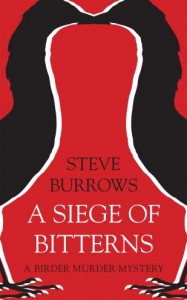 It was on Mother’s Day weekend that we visited Blue Heron Books in Uxbridge, the same day that Steve Burrows was appearing there to promote his book, A Siege of Bitterns. I was happy to buy a copy, as I’d been intrigued with his novel about a birdwatching detective, and I was so pleased to absolutely adore it. Unsurprisingly—the book has received rave reviews. The crux to the mystery’s solution involved not just birdwatching, but grammar. This book is a geek’s paradise. I’ve also been pleased to have happy readers reporting back after following my recommendation for this one. And good news: Burrows next title in the Birder Murder Mystery series is A Pitying of Doves, out this spring. I am so excited.
It was on Mother’s Day weekend that we visited Blue Heron Books in Uxbridge, the same day that Steve Burrows was appearing there to promote his book, A Siege of Bitterns. I was happy to buy a copy, as I’d been intrigued with his novel about a birdwatching detective, and I was so pleased to absolutely adore it. Unsurprisingly—the book has received rave reviews. The crux to the mystery’s solution involved not just birdwatching, but grammar. This book is a geek’s paradise. I’ve also been pleased to have happy readers reporting back after following my recommendation for this one. And good news: Burrows next title in the Birder Murder Mystery series is A Pitying of Doves, out this spring. I am so excited.
Purchase A Siege of Bitterns from McNally Robinson
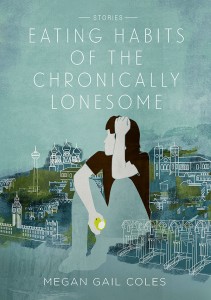 I’m so grateful to the good people at All Lit Up, without whom I might never have discovered Megan Gail Coles and her story collection Eating Habits of the Chronically Lonesome. Which contains this paragraph: “The reason Garry did these things was ’cause he couldn’t afford any better. Half of what he earned over at Pretty Paws was carted off to Newfoundland. Child support for an autistic kid he had with Slutty Marie down Gilbert Street, this the result of a one night stand./ Have you ever heard a sadder story, Dame? I mean, really? I barely poked her. We weren’t even lying down. It’s like her body sucked me sperm right inside her that night, vacuum cunt on her. Don’t ever have a go at the neighbourhood whore in an alley. Nothing good will come of it.” How could you not want to read this book?
I’m so grateful to the good people at All Lit Up, without whom I might never have discovered Megan Gail Coles and her story collection Eating Habits of the Chronically Lonesome. Which contains this paragraph: “The reason Garry did these things was ’cause he couldn’t afford any better. Half of what he earned over at Pretty Paws was carted off to Newfoundland. Child support for an autistic kid he had with Slutty Marie down Gilbert Street, this the result of a one night stand./ Have you ever heard a sadder story, Dame? I mean, really? I barely poked her. We weren’t even lying down. It’s like her body sucked me sperm right inside her that night, vacuum cunt on her. Don’t ever have a go at the neighbourhood whore in an alley. Nothing good will come of it.” How could you not want to read this book?
Purchase Eating Habits of the Chronically Lonesome from McNally Robinson
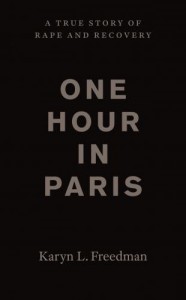 Unfortunately, as 2014 progressed, Karyn L. Freedman’s One Hour in Paris: A True Story of Rape and Recovery only became more and more important. I read it last spring as I pushed my baby in a swing. “The world, [Freedman] tells us with two decades of perspective in addition to her own violent rape, is a dangerous place for women, as statistics demonstrate in places as close as our own neighbourhoods and as far away as the war-wracked Congo. But nobody talks about these experiences, suggesting that such incidents are rare, suggesting to those lucky enough to not know better that sexual violence is a crime of circumstance, that it’s something most of us should be able to sidestep. It’s why newspaper columnists suggest that if a young woman refrains from drinking to excess, she might not get raped, and if she is raped, she should have known better. Thereby perpetuating victim’s sense of her own complicity in the crime against her, ensuring her silence, and so the cycle continues.” I’m so pleased that this book has been shortlisted for the BC National Non-Fiction Award.
Unfortunately, as 2014 progressed, Karyn L. Freedman’s One Hour in Paris: A True Story of Rape and Recovery only became more and more important. I read it last spring as I pushed my baby in a swing. “The world, [Freedman] tells us with two decades of perspective in addition to her own violent rape, is a dangerous place for women, as statistics demonstrate in places as close as our own neighbourhoods and as far away as the war-wracked Congo. But nobody talks about these experiences, suggesting that such incidents are rare, suggesting to those lucky enough to not know better that sexual violence is a crime of circumstance, that it’s something most of us should be able to sidestep. It’s why newspaper columnists suggest that if a young woman refrains from drinking to excess, she might not get raped, and if she is raped, she should have known better. Thereby perpetuating victim’s sense of her own complicity in the crime against her, ensuring her silence, and so the cycle continues.” I’m so pleased that this book has been shortlisted for the BC National Non-Fiction Award.
Purchase One Hour in Paris from McNally Robinson
 I read Mommyblogs and the Changing Face of Motherhood by May Friedman in September, and it was huge for me for all kinds of reasons. It laid the framework for the latest session of my blogging course, convinced me of the usefulness of academic theory for the very first time, and also that the history of women and blogging is one that is seriously under-documented and certainly worth telling. While Friedman’s research pertains to mommyblogs in particular (and her conclusions are always surprising, illuminating—if mommyblogs seem tired to you, she invites you to think again), it’s also hugely relevant to women and blogging in general, and is a fascinating and nuanced depiction of 21st century motherhood. And mostly, I am so struck by her notions of the usefulness of uncertainty (which reminded me of Rebecca Solnit, and ultimately led to cake): “In trying to form conclusions about mommybloggers—and about mothers—I am reminded of my children attempting to jump upon their own shadows: I am attempting to trap an essentially untrappable form of knowledge. After the initial discomfort and frustration that this inconclusive conclusion elicits, however, I have found that there is much to gained, as a researcher in general and as a motherhood researcher in particular, in looking instead at uncertainty as a valuable critical lens.” Feminism desperately needs this kind of approach, which is a fitting response to the complexity of actual people and the world.
I read Mommyblogs and the Changing Face of Motherhood by May Friedman in September, and it was huge for me for all kinds of reasons. It laid the framework for the latest session of my blogging course, convinced me of the usefulness of academic theory for the very first time, and also that the history of women and blogging is one that is seriously under-documented and certainly worth telling. While Friedman’s research pertains to mommyblogs in particular (and her conclusions are always surprising, illuminating—if mommyblogs seem tired to you, she invites you to think again), it’s also hugely relevant to women and blogging in general, and is a fascinating and nuanced depiction of 21st century motherhood. And mostly, I am so struck by her notions of the usefulness of uncertainty (which reminded me of Rebecca Solnit, and ultimately led to cake): “In trying to form conclusions about mommybloggers—and about mothers—I am reminded of my children attempting to jump upon their own shadows: I am attempting to trap an essentially untrappable form of knowledge. After the initial discomfort and frustration that this inconclusive conclusion elicits, however, I have found that there is much to gained, as a researcher in general and as a motherhood researcher in particular, in looking instead at uncertainty as a valuable critical lens.” Feminism desperately needs this kind of approach, which is a fitting response to the complexity of actual people and the world.
Purchase Mommyblogs and the Changing Face of Motherhood from McNally Robinson
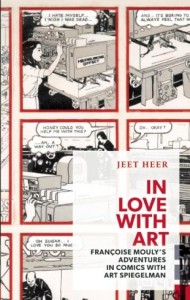 I remember reading In Love With Art by Jeet Heer on one of the first few days this spring when it was warm enough outside to walk and read without mittens, or it’s possible that it wasn’t actually that warm, but I was just enjoying the book so much. Francoise Mouly is a fascinating biographical subject, and I’d never heard of her, but unbeknownst to me, I’d seen her work—she was a long-time Art Editor of The New Yorker, and she’s the founder and Editorial Director of TOON Books, whose books we’re in love with at our house. And thisbook found its way into my (cold) hands just as Harriet was started to really get into comics, so I was pleased to learn so much about comics as an art form, and also the process behind comics creation, and what is entailed by the role of their editor. It was an excellent book, part of Coach House Books’ Exploded Views series of short books about big things, and I do love me a paperback that fits in my pocket.
I remember reading In Love With Art by Jeet Heer on one of the first few days this spring when it was warm enough outside to walk and read without mittens, or it’s possible that it wasn’t actually that warm, but I was just enjoying the book so much. Francoise Mouly is a fascinating biographical subject, and I’d never heard of her, but unbeknownst to me, I’d seen her work—she was a long-time Art Editor of The New Yorker, and she’s the founder and Editorial Director of TOON Books, whose books we’re in love with at our house. And thisbook found its way into my (cold) hands just as Harriet was started to really get into comics, so I was pleased to learn so much about comics as an art form, and also the process behind comics creation, and what is entailed by the role of their editor. It was an excellent book, part of Coach House Books’ Exploded Views series of short books about big things, and I do love me a paperback that fits in my pocket.
Purchase In Love With Art from McNally Robinson
 I only read The Bookshop That Floated Away last week, but I was so taken by Sarah Henshaw’s book, and I think that I’ll continue to be as much. We’re planning at trip to the UK in the spring, and top of my list of things to do there is tracking down the book barge. It’s the ideal book for anyone who ever thought that opening a book on a boat sounded like a perfectly sensible idea, and I loved its unabashed oddness, the absurd adventure, and all the references to books and reading, and also to Victoria Sponge Cake.
I only read The Bookshop That Floated Away last week, but I was so taken by Sarah Henshaw’s book, and I think that I’ll continue to be as much. We’re planning at trip to the UK in the spring, and top of my list of things to do there is tracking down the book barge. It’s the ideal book for anyone who ever thought that opening a book on a boat sounded like a perfectly sensible idea, and I loved its unabashed oddness, the absurd adventure, and all the references to books and reading, and also to Victoria Sponge Cake.
Purchase The Bookshop That Floated Away
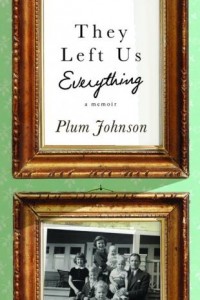 Plum Johnson’s They Left Us Everything was the most terrific memoir, ostensibly the story of a woman cleaning out her parents’ house after their deaths, but it’s also a record of a wonderful family history, about the curious shape and contents of archives and the stories they tell, about caring for aging parents, coming to terms with the past, the complexities of daughterhood and motherhood, and understanding our parents as people in their own right. I’m so pleased that it’s been nominated for the 2015 Charles Taylor Prize for Non-Fiction.
Plum Johnson’s They Left Us Everything was the most terrific memoir, ostensibly the story of a woman cleaning out her parents’ house after their deaths, but it’s also a record of a wonderful family history, about the curious shape and contents of archives and the stories they tell, about caring for aging parents, coming to terms with the past, the complexities of daughterhood and motherhood, and understanding our parents as people in their own right. I’m so pleased that it’s been nominated for the 2015 Charles Taylor Prize for Non-Fiction.
Purchase They Left Us Everything from McNally Robinson
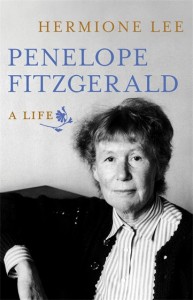 Hermione Lee’s biography, Penelope Fitzgerald: A Life, was the first book I finished in 2014, and it was how I spent my holidays—so so delightful. And anti-social. Biographers don’t come much better than Lee, and lives are rarely more interesting than Penelope Fitzgerald’s—though hers did pose a challenge for the biographer considering that all her early papers were lost when her houseboat sunk on the Thames during the 1960s (where she was living in abject poverty, barely supporting her three children. She went on to publisher her first book at age 60, won the Booker Prize at 7o). Fitzgerald’s novels had always seemed obscure to me, but their author’s life story has cast them in a new light (and I am excited for the new editions with covers by Julie Morstad).
Hermione Lee’s biography, Penelope Fitzgerald: A Life, was the first book I finished in 2014, and it was how I spent my holidays—so so delightful. And anti-social. Biographers don’t come much better than Lee, and lives are rarely more interesting than Penelope Fitzgerald’s—though hers did pose a challenge for the biographer considering that all her early papers were lost when her houseboat sunk on the Thames during the 1960s (where she was living in abject poverty, barely supporting her three children. She went on to publisher her first book at age 60, won the Booker Prize at 7o). Fitzgerald’s novels had always seemed obscure to me, but their author’s life story has cast them in a new light (and I am excited for the new editions with covers by Julie Morstad).
Purchase Penelope Fitzgerald: A Life from McNally Robinson
 And oh! Adult Onset by Ann-Marie MacDonald, the book that inspired me to write over 1300 words in response. I love how this book has been everything to everybody—I read the review that said it was about anxiety, the one that said it was about being queer, and to me it was all about motherhood. What a fascinating book that can be read through so many different lenses. I also am intrigued by the weird and wonderful ways Adult Onset flirts with genre, oh so subtly. It’s a book about parallel lives and parallel universes, ordinary city sidewalks rendered fantastic.
And oh! Adult Onset by Ann-Marie MacDonald, the book that inspired me to write over 1300 words in response. I love how this book has been everything to everybody—I read the review that said it was about anxiety, the one that said it was about being queer, and to me it was all about motherhood. What a fascinating book that can be read through so many different lenses. I also am intrigued by the weird and wonderful ways Adult Onset flirts with genre, oh so subtly. It’s a book about parallel lives and parallel universes, ordinary city sidewalks rendered fantastic.
Purchase Adult Onset by McNally Robinson
 Speaking of sidewalks, I still remember walking up Bay Street toward the subway in August reading Thunderstruck and Other Stories by Elizabeth McCracken, a hardback no-less. I was hooked from the first delicious sentence: “Just west of Boston, just north of the turnpike, the ghost of Missy Goodby sleeps curled up against the cyclone fence at the dead end of Winter Terrace, dressed in a pair of ectoplasmic dungarees.” I loved this book, and its stories: “Many of them are about grief, about the peculiarity of details during the times in life in which we’re grief-struck, or stricken at all. They’re about human connection in surprising places, about misunderstandings in which the connection is missed. Their about the things that get lost and what we choose to preserve. They’re funny even with the sadness, a many sided shape. And they’re absolutely extraordinary.”
Speaking of sidewalks, I still remember walking up Bay Street toward the subway in August reading Thunderstruck and Other Stories by Elizabeth McCracken, a hardback no-less. I was hooked from the first delicious sentence: “Just west of Boston, just north of the turnpike, the ghost of Missy Goodby sleeps curled up against the cyclone fence at the dead end of Winter Terrace, dressed in a pair of ectoplasmic dungarees.” I loved this book, and its stories: “Many of them are about grief, about the peculiarity of details during the times in life in which we’re grief-struck, or stricken at all. They’re about human connection in surprising places, about misunderstandings in which the connection is missed. Their about the things that get lost and what we choose to preserve. They’re funny even with the sadness, a many sided shape. And they’re absolutely extraordinary.”
Purchase Thunderstruck from McNally Robinson
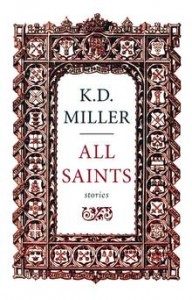 Last summer I reviewed All Saints by KD Miller in The Globe and Mail. “Most of [Miller’s characters] are searching for meaning; Miller – in language that doesn’t draw attention to itself, but bends to suit her purposes – uses the small moments in life to illuminate big questions. Where did the story start? What is destiny? Is there an order to the universe, to a life? But a life, we learn, is only a piece of the puzzle, meaning and wholeness only emerging when separate lives connect. Crucially and compellingly, such connections are mysterious – Miller shows how we are all figments of one and other’s imaginations.”
Last summer I reviewed All Saints by KD Miller in The Globe and Mail. “Most of [Miller’s characters] are searching for meaning; Miller – in language that doesn’t draw attention to itself, but bends to suit her purposes – uses the small moments in life to illuminate big questions. Where did the story start? What is destiny? Is there an order to the universe, to a life? But a life, we learn, is only a piece of the puzzle, meaning and wholeness only emerging when separate lives connect. Crucially and compellingly, such connections are mysterious – Miller shows how we are all figments of one and other’s imaginations.”
Purchase All Saints from McNally Robinson
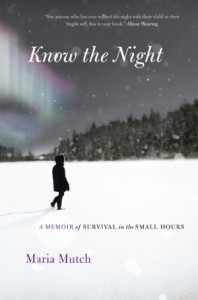 For a few weeks in February, I was deep into the memoir Know the Night by Maria Mutch, which I reviewed for The National Post, a book I read twice and puzzled through with so many notes, and figured out like a complicated math problem—so utterly engaging. All to the soundtrack of “Mercy Mercy Mercy” by Cannonball Adderley. “Know the Night, a memoir about a boy who doesn’t speak, is in love with language. Mutch’s prose is electric (when describing her relationship with her partner, she writes of “that ingredient vital for love, which can best be described, I think, as conspiracy” — my favourite line in the book) but the book is more concerned with words than the stories they tell. Mutch probes the connections between words and what they symbolize, as well as other connections for which words are a conduit.”
For a few weeks in February, I was deep into the memoir Know the Night by Maria Mutch, which I reviewed for The National Post, a book I read twice and puzzled through with so many notes, and figured out like a complicated math problem—so utterly engaging. All to the soundtrack of “Mercy Mercy Mercy” by Cannonball Adderley. “Know the Night, a memoir about a boy who doesn’t speak, is in love with language. Mutch’s prose is electric (when describing her relationship with her partner, she writes of “that ingredient vital for love, which can best be described, I think, as conspiracy” — my favourite line in the book) but the book is more concerned with words than the stories they tell. Mutch probes the connections between words and what they symbolize, as well as other connections for which words are a conduit.”
Purchase Know the Night from McNally Robinson
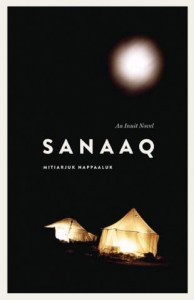 Another winter book I read around the same time was Sanaaq by Mitiarjuk Nappaaluk. Nappaaluk had been asked to write down some Inuktitut phrases for a missionary to learn, but didn’t stop at simple grammar exercises and went on invent a whole cast of characters and create the first Inuit novel. “The narrative skirts omniscience in a way that seems curious to the reader who is accustomed to the English novel. There is a matter-of-factness to the telling, perhaps related to its origins—it was written in a shorthand that can be written as quickly as it is spoken, and so this written novel has an oral nature. There is also a simplicity to its delivery that only comes across as such because a whole layer of the narrative is inaccessible to me as a reader (and I think that this is the challenge for this reader that Martin was writing about in her review). Saladin d’Anglure’s foreword makes clear that the apparent simplicity of Nappaaluk’s novel is undermined by the Inuit symbols and stories referenced, as well as details of Nappaaluk’s own life and members of her community. In short, this is only a straightforward story because I’m not smart enough to know it isn’t otherwise.”
Another winter book I read around the same time was Sanaaq by Mitiarjuk Nappaaluk. Nappaaluk had been asked to write down some Inuktitut phrases for a missionary to learn, but didn’t stop at simple grammar exercises and went on invent a whole cast of characters and create the first Inuit novel. “The narrative skirts omniscience in a way that seems curious to the reader who is accustomed to the English novel. There is a matter-of-factness to the telling, perhaps related to its origins—it was written in a shorthand that can be written as quickly as it is spoken, and so this written novel has an oral nature. There is also a simplicity to its delivery that only comes across as such because a whole layer of the narrative is inaccessible to me as a reader (and I think that this is the challenge for this reader that Martin was writing about in her review). Saladin d’Anglure’s foreword makes clear that the apparent simplicity of Nappaaluk’s novel is undermined by the Inuit symbols and stories referenced, as well as details of Nappaaluk’s own life and members of her community. In short, this is only a straightforward story because I’m not smart enough to know it isn’t otherwise.”
Purchase Sanaaq from McNally Robinson
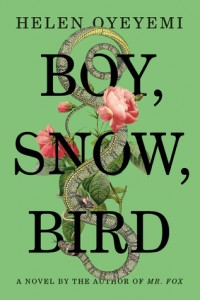 Helen Oyeyemi’s Boy Snow Bird was one of my vacation reads this summer, and I was enthralled by its twists and turns, and by how the British-born Oyeyemi channels American-ness in this novel. That it was based on a fairy tale might have had me supposing a certain shallowness to the narrative, but Oyeyemi drills down deep to show why an archetypal story like Snow White has such cultural resonance, and then introduces race as a theme to add a whole new layer of relevance. This novel was smart, sharp and gorgeous.
Helen Oyeyemi’s Boy Snow Bird was one of my vacation reads this summer, and I was enthralled by its twists and turns, and by how the British-born Oyeyemi channels American-ness in this novel. That it was based on a fairy tale might have had me supposing a certain shallowness to the narrative, but Oyeyemi drills down deep to show why an archetypal story like Snow White has such cultural resonance, and then introduces race as a theme to add a whole new layer of relevance. This novel was smart, sharp and gorgeous.
Purchase Boy, Snow, Bird from McNally Robinson
 I also adored Ruth Ozeki’s A Tale for the Time Being, which I read in April. Late to the party (because it had already been internationally celebrated by then) I read it for own pleasure, and realized it deserved all the hype. At heart, this is a novel about quantum physics, which shouldn’t scare you off. It’s a weird, wonderful story about the whole wide world, which is as terrible as it is beautiful, and it’s brilliant how Ozeki manages to knit it all together.
I also adored Ruth Ozeki’s A Tale for the Time Being, which I read in April. Late to the party (because it had already been internationally celebrated by then) I read it for own pleasure, and realized it deserved all the hype. At heart, this is a novel about quantum physics, which shouldn’t scare you off. It’s a weird, wonderful story about the whole wide world, which is as terrible as it is beautiful, and it’s brilliant how Ozeki manages to knit it all together.
Purchase A Tale for the Time Being from McNally Robinson
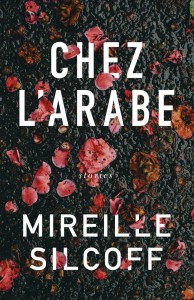 I haven’t talked much here about Chez L’Arabe by Mireille Silcoff, which I read this fall, but I loved it and my review is forthcoming in Canadian Notes & Queries. From my review: One can read Silcoff’s collection as a catalogue of beautiful well-made objects…Which is not to say that the stories lack depth, that they skim along their lush or shiny surfaces, but instead the things themselves are invested with meaning, each one “permeated with some little, important, imported world of its own.” “Materialist” is hurled as a slur more than once but, as a character replies (she of the sugar sifter), “I don’t see why anything should be considered less meaningful just because it’s concrete.””
I haven’t talked much here about Chez L’Arabe by Mireille Silcoff, which I read this fall, but I loved it and my review is forthcoming in Canadian Notes & Queries. From my review: One can read Silcoff’s collection as a catalogue of beautiful well-made objects…Which is not to say that the stories lack depth, that they skim along their lush or shiny surfaces, but instead the things themselves are invested with meaning, each one “permeated with some little, important, imported world of its own.” “Materialist” is hurled as a slur more than once but, as a character replies (she of the sugar sifter), “I don’t see why anything should be considered less meaningful just because it’s concrete.””
Purchase Chez L’Arabe from McNally Robinson
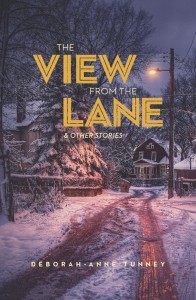 Deborah-Anne Tunney’s The View From the Lane was another recent read, but one I’ve not been able to shake off yet. It was a promising first book more than a perfect one, but a huge part of its promise is the atmosphere that Tunney creates. It reminded me of Atwood’s Cat’s Eye and Isabel Huggan’s The Elizabeth Stories in all the best ways. The night I finished this book, I stayed up late searching for the streets she writes about on Google Maps—I was left with such a sense of the place, and I wanted to see it for myself.
Deborah-Anne Tunney’s The View From the Lane was another recent read, but one I’ve not been able to shake off yet. It was a promising first book more than a perfect one, but a huge part of its promise is the atmosphere that Tunney creates. It reminded me of Atwood’s Cat’s Eye and Isabel Huggan’s The Elizabeth Stories in all the best ways. The night I finished this book, I stayed up late searching for the streets she writes about on Google Maps—I was left with such a sense of the place, and I wanted to see it for myself.
Purchase The View from the Lane by Deborah-Anne Tunney
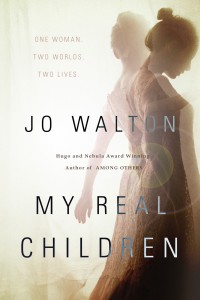 And finally, My Real Children by Jo Walton, a book I loved so very much and have given as a gift at least three times since I read it (and I replaced my ARC with a hardcover). Lots to say about this one—it connects interestingly with Lisa Bird-Wilson’s Just Pretending in its notion of real children (those we give birth to) as opposed to those who are miscarried or adopted and the “unrealness” that pervades these relationships through semantics. And with Ann-Marie MacDonald’s book, which also explores queer relationships and parallel lives. I reread this book for my book club and realized that while Walton’s strength is not as a prose stylist—there are a few lines in the book that are a bit painful to encounter—she has performed something remarkable in her creation of Patricia Cowan and her lives, so much so that this book reminded be of Hermione Lee’s Penelope Fitzgerald biography (Fitzgerald and Walton’s Patricia are near contemporaries). I’m going to be returning to this book again and again for the enthralling nature of its story, for its genre blurring and alternate histories, and for what Walton has to say about the shape and the details of an ordinary woman’s life.
And finally, My Real Children by Jo Walton, a book I loved so very much and have given as a gift at least three times since I read it (and I replaced my ARC with a hardcover). Lots to say about this one—it connects interestingly with Lisa Bird-Wilson’s Just Pretending in its notion of real children (those we give birth to) as opposed to those who are miscarried or adopted and the “unrealness” that pervades these relationships through semantics. And with Ann-Marie MacDonald’s book, which also explores queer relationships and parallel lives. I reread this book for my book club and realized that while Walton’s strength is not as a prose stylist—there are a few lines in the book that are a bit painful to encounter—she has performed something remarkable in her creation of Patricia Cowan and her lives, so much so that this book reminded be of Hermione Lee’s Penelope Fitzgerald biography (Fitzgerald and Walton’s Patricia are near contemporaries). I’m going to be returning to this book again and again for the enthralling nature of its story, for its genre blurring and alternate histories, and for what Walton has to say about the shape and the details of an ordinary woman’s life.



